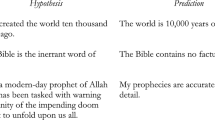Abstract
Andreas Libavius’ (c. 1555–1616) three part collection of letters, the Rerum chymicarum epistolica forma ... liber (1595–1599) is a particularly important text in fashioning the subject of chemistry as a demonstrative science and as a didactic discipline. Where Libavius’ Alchemia, which some have claimed to be the first textbook of chemistry, had mostly a humanist agenda, the Rerum chymicarum ... liber more directly sought to wrest the subject of “chemistry” away from Paracelsian adepts, and established the methodological basis for a specific form of knowledge suitable to the university. Making use of Aristotle’s Posterior analytics Libavius created a “floor-plan” for chemistry that integrated practical experience with natural philosophy, and could thus, he claimed, penetrate more deeply into the structure of nature than other academic disciplines.
Similar content being viewed by others
References
Aristotle: 1960, Posterior analytics, trans. E.S. Forster, Harvard University Press, Cambridge, Mass
R. Bacon (1732) ‘Radix mundi’ Roth-Scholtzen Friedrich (Eds) Deutsches Theatrum Chemicum Adam Jonathan Felssecker Nürnberg 24–72
Boyle, R.: 1690, The Christian Virtuoso, printed by Edw. Jones, London.
Cicero: 1927, Tusculan Disputations, trans. J.E. King, William Heinemann, London/G.P. Putnam’s Sons, New York.
Clericuzio A.: ‘Carneades and the chemists: a study of The Sceptical Chymist and its impact on seventeenth-century chemistry’, in M. Hunter (ed.), Robert Boyle Reconsidered, Cambridge University Press, Cambridge, pp. 79–90.
B.J.T. Dobbs (1990) ‘From the secrecy of alchemy to the openness of chemistry’ T. Frängsmyr (Eds) Solomon’s House Revisited: The Organization and Institutionalization of Science Science History Publications Canton Mass
O. Hannaway (1975) The Chemists and the Word: The Didactic Origins of Chemistry Johns Hopkins Press Baltimore
O. Hannaway (1986) ArticleTitle‘Laboratory design and the aim of science: Andreas Libavius vs Tycho Brahe’ Isis 77 585–610 Occurrence Handle10.1086/354267
J. Hornung (1625) Cista Medica, Quid est Espistolae Clarissimorum Germaniae Medicorum ... Simonis Halbmayri Norimbergae
Libavius, A.: 1595, Rerum Chymicorum Epistolica ... Liber Primus ... Secundus, excudebat Ioannes Saurius, impensis Petri Kopffij, Francofurti.
Libavius, A.: 1599, Epistolarum Chymicarum ... Liber Tertius, in officina typographica Ioannis Lechleri, impensis Petri Kopffij, Francofurti.
Libavius, A.: 1597, Alchemia, excudebat Ioannes Saurius, impensis Petri Kopffij, Francofurti.
Libavius, A.: 1606, Alchymia ... Recognita, Emendata, et Aucta, excubebat Ioannes Saurius, impensis Petri Kopffij, Francofurti.
Libavius, A.: 1613, `Liber hypomnematum’. in Syntagmatis selectorum undiquaque et perspicue traditorum Alchymiae Arcanorum ... Tomus secundus, excudebat Nicolaus Hoffmannus, impensis Petri Kopffij, Francofurti.
Libavius, A.: 1615, Pro defensione et declaratione syntagmatis chymici, contra reprehensiones Henningi Scheunemani. in Appendix necessaria syntagmatis arcanorum chymicorum, excudebat Nicolaus Hoffmannus, impensis Petri Kopffij, Francofurti.
Newman W.: ‘Alchemical symbolism and concealment’, in P. Gallison and E. Thompson (eds.), The Architecture of Science, MIT Press, Cambridge Mass, pp. 59–77.
Shackelford J.: ‘Tycho Brahe, laboratory design, and the aim of science: reading plans in context’, Isis 84, 211–230.
Author information
Authors and Affiliations
Corresponding author
Rights and permissions
About this article
Cite this article
Moran, B.T. Axioms, Essences, and Mostly Clean Hands: Preparing to Teach Chemistry with Libavius and Aristotle. Sci Educ 15, 173–187 (2006). https://doi.org/10.1007/s11191-004-2013-1
Issue Date:
DOI: https://doi.org/10.1007/s11191-004-2013-1




